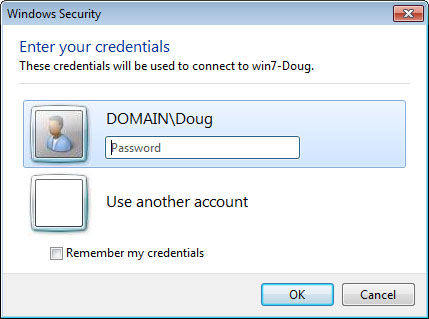1. Click the Start button and type the word Remote. Then click the Remote Desktop Connection icon.
The Remote Desktop Connection client comes to life, as shown here.
 Connecting with Remote Desktop Connection.
Connecting with Remote Desktop Connection.2. Enter the name of the computer you want to connect to.
Alternatively, you can use the drop-down list to select the computer from the list of available computers.
You can also enter the IP address of the computer you want to connect to.
3. Click the Connect button.
You’re connected to the computer you selected, and then prompted for login credentials, as shown here.
 Logging in to a remote computer.
Logging in to a remote computer.4. Enter your username and password, and then click OK.
Assuming you enter valid credentials, the desktop of the remote computer is displayed, as shown here.
 The desktop of the remote computer.
The desktop of the remote computer.5. Use the remote computer!
You may notice in the figure that the Remote Desktop window is not large enough to display the entire desktop of the remote computer. As a result, scroll bars appear to allow you to scroll the desktop horizontally or vertically. You can always maximize the Remote Desktop window to see the entire desktop of the remote computer.
Here are a few other tips for working with Remote Desktop Connection:
- Remote Desktop allows only one user at a time to log in to the remote computer. If another user is remotely logged in when you try to connect, you’ll get a notice informing you that another user is already logged on. You can either cancel or attempt to barge in on the other user’s remote session. If you choose the latter option, the other user will see a message stating that you want to connect. If the other user accepts your request, the other user is logged off and you’re logged in. If the other user denies your request, your attempt to log in is canceled. If the user does not respond, eventually Windows will kick the other user off and let you in.
- When you’re using the Remote Desktop Connection client, you can’t just press Alt+Tab to get another program running on the client computer. Instead, you must first minimize the RDC client’s window by clicking its minimize button. Then you can access other programs running on your computer.
- If you minimize the RDC client window, you have to provide your logon credentials again when you return. This security feature is there in case you forget that you have an RDC session open.
If you use RDC a lot on a particular computer (such as your own desktop computer), create a shortcut to RDC and place it on the desktop, at the top of the Start menu, or in the Quick Launch portion of the taskbar.
- RDC has several useful configuration options that you can access by clicking the Options button.





